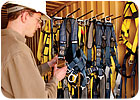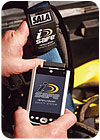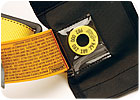
OSHA regulations for fall protection in the construction industry state that employers must provide fall protection systems on working surfaces with unprotected edges where the next surface is six feet or more below. This includes scaffolding and low- and steep-sloped roofs in both residential and commercial applications.
Although safety concerns are of paramount importance, workers sometimes skip the safety precaution of donning a harness and tying off to an anchorage, citing the misconceived notion that doing so is a lengthy process. Couple this attitude with the real hassles of inventory control and the associated paperwork nightmare of tracking past and upcoming inspections, and it’s no wonder that many workers are not as safe on the job as they should be.
Technological advances have made ease-of-use concerns obsolete. Products are available now that are quick to install, allow for complete worker mobility and don’t damage the scaffold or roof. Some anchorages may be left on a roof structure for future maintenance, while others may be ‘knocked down’ and covered. Traditional anchors that must be disassembled and disposed of are also available.
Fortunately, inventory control is a whole lot easier, thanks to computer technology. The days of logging inspections and equipment assignments on paper are over! Widely recognized in other industries as an ideal information tracking tool, radio frequency identification (RFID) is now entering the safety arena to simplify record keeping for equipment and supplies.

How it works
Just over a year ago, Capital Safety, manufacturer of the DBI-SALA and PROTECTA brands, introduced i-Safe Intelligent Safety System. i-Safe is the first comprehensive RFID system for fall protection equipment. The system is comprised of several synchronized parts: RFID tags, PDA (personal digital assistant) readers, a Web portal and retrofitting kits.Each RFID tag is programmed with a unique identification that registers model type and history of the equipment to which it is attached. The passive tag emits radio waves that transmit a variety of coded information to the PDA, which is equipped with a reader. The PDA displays the product make and model and upcoming and past inspections, in addition to jobsite and worker assignments. This data is linked to a personalized Web portal which can provide further information including user manuals, inspection checklists, training records, industry regulations, product advisories and other useful links.
i-Safe RFID tags are now standard on all DBI-SALA products and retrofitting kits are available for all types of equipment, regardless of brand, to extend the benefits of this technology to existing inventory. To start electronic record keeping with the retrofitting kits, the tag is simply attached to the equipment and a prompt will instruct the user to enter model number, make and date of manufacture.
Value
Ralph Tabak, equipment manager with TIC-Canada (a heavy industrial construction company and subsidiary of TIC International), explains that the benefits of i-Safe far outweigh the cost.“Dollar savings and man-hour savings will be phenomenal for us in the long-run,” Tabak said. “One of my greatest pet peeves is having equipment come back from a jobsite with multiple contractors and we’ll be missing harnesses and lanyards. We’ve also had equipment returned from jobsites that have been left in the elements and we’ll have an 80 percent rejection rate.”
Tabak and his colleague, Ken Fecteau, warehouse supervisor, turned to Rick Selthun with Capital Safety for assistance with these problems.
“We asked if it was possible to purchase harnesses and lanyards in company colors and he said ‘yes.’ But then we began talking about i-Safe, so we had him come out and preview the system in our office. Our first comment was ‘wow!’ we want to be a part of this.”
TIC-Canada was the first company in Canada to implement the i-Safe system. Tabak and Fecteau are working to outfit each of the company’s estimated 300 pieces of fall protection equipment with RFID tags. Although only in use for five months, as of August, the system has already shown its merits.
“i-Safe offers us reliable traceability. We can tell exactly who has what harness or lanyard and exactly where they are. We can go onto the i-Safe site and we can see everything at a quick glance rather than going through books and paperwork number by number. We cross reference our barcode number with the chip number on the equipment. It saves us a lot of time,” Fecteau said.
i-Safe was designed to maximize the effectiveness and minimize the total cost of safety programs. With i-Safe, there’s no log book to locate and no messy handwriting to decipher. At the click of a mouse, compliance can be verified and the location of the equipment can be determined. This cuts down on the safety director’s and equipment manager’s time in tracking gear and ensuring that inspections have been performed. Tabak and Fecteau estimate that the system saves them 6-10 hours per week.
The system also provides a level of accountability, which can reduce misplacement and mishandling. At jobsites with multiple contractors, i-Safe can determine which company a piece of equipment belongs to. If something is left outside at a jobsite and exposed to the elements, it can be traced back to the person responsible for the equipment. This will prolong the life of the equipment and cut costs by reducing the number of harnesses, lanyards and lifelines that need to be replaced due to exposure or loss.
Tabak and Fecteau were also impressed with the system’s ease-of-use.
“It’s not cumbersome,” Tabak said. “It’s a very easy program to deal with.”
“I’ve been pretty impressed with the system. It’s very user-friendly,” Fecteau concurred. “For a guy like me, who’s not 100 percent computer savvy, I can get in there, work my way around and understand exactly what’s going on and know what I’m doing.”

Longevity
i-Safe has already been improved from its initial software package. Version 2, which TIC-Canada’s input helped to shape, has customizable features based on feedback from companies that adopted the system when it was introduced. The software will evolve alongside products so the system won’t become outdated.The hardware was also designed with longevity in mind. The RFID tags have no battery and consequently do not need to be replaced. The tags are also resistant to dirt, grease and grime, unlike other tracking systems such as barcodes. The system features several other advantages over barcodes: they do not require a direct line of sight to scan and they can be read from greater distances. Spark hazards and interference are not a concern with the system because the RFID chips operate at a low energy level.
The long-term potential for i-Safe is extremely promising. Companies including TIC-Canada are looking at expanding RFID tracking to other pieces of equipment such as pressure gauges, which need to be constantly calibrated. Knowing where every piece of a company’s equipment is at any given time is not out of the realm of possibility 10 years down the line.
Conclusion
When asked if they would have done anything differently in implementing the i-Safe system, Tabak replied, “We would have done it earlier.” TIC-Canada has been so impressed with the system, that when asked by vendors and other companies about it, they’ve invited them to come to TIC-Canada’s facilities to review it in person.“We feel that other companies will appreciate the transparency the system provides,” Fecteau said. “The knowledge of where our equipment is and the status of it is extremely valuable.”
“It’s a product we believe in,” Tabak said. “If we didn’t believe in it we wouldn’t be using it.”

Report Abusive Comment